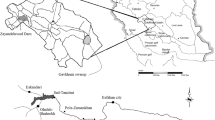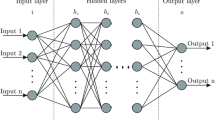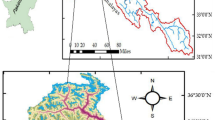Abstract
The accurate prediction of hourly runoff discharge in a river basin during typhoon events is of critical importance in operational flood control and management. This study utilizes three model approaches to predict runoff discharge in the Laonong Creek basin in southern Taiwan: the hydrological engineering center hydrological modeling system (HEC-HMS) model and two hybrid models which combine the HEC-HMS model with a genetic algorithm neural network (GANN) and an adaptive neuro-fuzzy inference system approach (ANFIS). Hourly runoff discharge data during seven heavy rainfall/typhoon events were collected for model calibration (training) and validation. Six statistical indicators [i.e., mean absolute error, root-mean-square error, coefficient of correlation, error of time to peak discharge, error of peak discharge, and coefficient of efficiency (CE)] were used to evaluate the prediction accuracy. The simulation results indicate that the HEC-HMS model cannot satisfactorily predict hourly runoff discharge during the typhoon events. Both hybrid approaches that use the HEC-HMS model in conjunction with the GANN and ANFIS models can significantly improve the prediction accuracy for the n-h-ahead runoff discharge.















Similar content being viewed by others
Explore related subjects
Discover the latest articles, news and stories from top researchers in related subjects.References
Wang W, Ding J (2003) Wavelet network model and its application to the prediction of hydrology. Nat Sci 1(1):67–71
Arabi M, Frankenberger JR, Engel BA, Arnold JG (2008) Representation of agricultural practices with SWAT. Hydrol Process 22(16):3042–3055
Pektas AO, Cigizoglu HK (2013) ANN hybrid model versus ARIMA and ARIMAX models of runoff coefficient. J Hydrol 500:21–36
Joo J, Kjeldsen T, Kim HJ (2014) A comparison of two event-based flood models (ReFH-rainfall runoff model and HEC-HMS) at two Korean catchments, Bukil and Jeungpyeong). KSCE J Civ Eng 18(1):330–343
Dawson CW, Wilby RL (2001) Hydrological modelling using artificial neural networks. Prog Phys Geogr 25(1):80–108
Abrahart RJ, Kneale PE, See L (2004) Neural networks for hydrological modelling. Taylor & Francis, New York, p 304
Tabari H, Marifi S, Abyaneh HZ, Sharifi MR (2010) Comparison of artificial neural network and combined models in estimating spatial distribution of snow depth and snow water equivalent in Samsami basin of Iran. Neural Comput Appl 19(4):625–635
Talei A, Chua LHC, Quek C, Jansson PE (2013) Runoff forecasting using a Takagi–Sugeno neuro-fuzzy model with online learning. J Hydrol 488:17–32
Machado F, Mine M, Kaviski E, Fill H (2011) Monthly rainfall–runoff modelling using artificial neural networks. Hydrol Sci J 56(3):349–361
Nourani V, Komasi M, Alami MT (2012) Hybrid wavelet-genetic programming approach to optimize ANN modeling of rainfall–runoff process. J Hydrol Eng ASCE 17(6):724–741
Rezaeianzadeh M, Tabari H, Yazdi AA, Isik S, Kalin L (2014) Flood flow forecasting using ANN, ANFIS and regression models. Neural Comput Appl 25(1):25–37
Rezaeianzadeh M, Stein A, Tabari H, Abghari H, Jalalkamali N, Hosseinipour EZ, Singh VP (2013) Assessment of a conceptual hydrological model and artificial neural networks for daily outflows forecasting. Int J Environ Sci Technol 10(6):1181–1192
Shamseldin AY, O’Connor KM (2001) A non-linear neural network technique for updating of river flow forecasts. Hydrol Earth Syst Sci 5(4):577–597
Xiong L, O’Connor KM (2002) Comparison of four updating models for real-time river flow forecasting. Hydrol Sci J 47(4):621–639
Shamseldin AY (1997) Application of a neural network technique to rainfall–runoff modelling. J Hydrol 199(3–4):272–294
See L, Abrahart RJ (2001) Multi-model data fusion for hydrological forecasting. Comput Geosci 27(8):987–994
Ajami NK, Duan Q, Gao X, Sorooshian S (2006) Multimodel combination techniques for analysis of hydrological simulations: application to distributed model intercomparison project results. J Hydrometeorol 7(4):755–768
Shamseldin AY, O’Connor KM, Nasr AE (2007) A comparative study of three neural network forecast combination methods for simulated river flows of different rainfall–runoff models. Hydrol Sci J 52(5):896–916
Viney NR, Bormann H, Breuer L, Croke BFW, Frede H, Graff T, Hubrechts L, Huisman JA, Jakeman AJ, Kite GW, Lanini J, Leavesley G, Lettenmaier DP, Lindstrom G, Seibert J, Sivapalan M, Willems P (2009) Assessing the impact of land use change on hydrology by ensemble modeling (LUCHEM). II: ensemble combinations and predictions. Adv Water Resour 32(2):147–158
Fernando AK, Shamseldin AY, Abrahart RJ (2012) Use of gene expression programming for multimodel combination of rainfall–runoff models. J Hydrol Eng 17(9):975–985
Phukoetphim P, Shamseldin AY, Melville BW (2014) Knowledge extraction from artificial neural networks for rainfall–runoff model combination system. J Hydrol Eng 19(7):1422–1429
Panda RK, Pramanik N, Bala B (2010) Simulation of river stage using artificial neural network and MIKE 11 hydrodynamic model. Comput Geosci 36(6):735–745
Napolitano G, See L, Calvo B, Savi F, Heppenstall A (2010) A conceptual and neural network model for real-time flood forecasting of the Tiber River in Rome. Phys Chem Earth 35(3–5):187–194
Talei A, Chua LHC, Wang TSW (2010) Evaluation of rainfall and discharge inputs used by adaptive network-based fuzzy inference systems (ANFIS) in rainfall–runoff modeling. J Hydrol 391(3–4):248–262
Young CC, Liu WC (2015) Prediction and modelling of rainfall–runoff during typhoon events using a physically-based and artificial neural network hybrid model. Hydrol Sci J (in press)
Feldman AD (2000) Hydrologic modeling system HEC-HMS. Technical reference manual. U.S. Army Corps of Engineers, Davis
US Army Corps Engineers (2008) Hydrologic modeling system (HEC-HMS) application guide: version 3.1.0. Institute for Water Resources, Davis
US Soil Conservation Service (1986) Urban hydrology for small watershed. Technical release 55. US Department of Agriculture
McCuen RH (1998) Hydrologic analysis and design. Prentice-Hall, Upper Saddle River, pp 155–163
Clark CO (1945) Storage and the unite hydrograph. Trans Am Soc Civil Eng 110:1419–1488
Chow VT, Maidment DR, Mays LW (1988) Applied hydrology. McGraw-Hill, New York
Goldberg DE (1989) Genetic algorithms in search, optimization and machine learning. Longman, New York
Karimi H, Yousefi F (2012) Application of artificial neural network-genetic algorithm (ANN-GA) to correlation of density in nanofluids. Fluid Phase Equilib 336:79–83
Ferentinos KP (2005) Biological engineering applications of feed forward neural networks designed and parameterized by genetic algorithms. Neural Netw 18(7):934–950
Karzynski M, Mateos A, Herrero J, Dopazo J (2003) Using a genetic algorithm and a perceptron for feature selection and supervised class learning in DNA microarray data. Artif Intell Rev 20(1–2):39–51
Jang JSR (1993) ANFIS: adaptive-network-based fuzzy inference system. IEEE Trans Syst Man Cybern 23(3):665–685
Nayak PC, Sudheer KP, Ragan DM, Ramasastri KS (2004) A neuro fuzzy computing technique for modeling hydrological time series. J Hydrol 291(1–20):52–66
MATLAB (2008) Fuzzy logic toolbox-user guide. The MathWorks, MA, USA
Young CC, Wu CH (2009) An efficient and accurate non-hydrostatic model with embedded Boussinesq-type like equations for surface wave modeling. Int J Numer Meth Fluids 60(1):27–53
Acknowledgments
This research was conducted with the support of the National Science Council Grant No. 102-2625-M-239-002. This financial support is greatly appreciated. The authors would like to express their appreciation to the Water Resources Agency for providing access to their recorded data.
Author information
Authors and Affiliations
Corresponding author
Rights and permissions
About this article
Cite this article
Young, CC., Liu, WC. & Chung, CE. Genetic algorithm and fuzzy neural networks combined with the hydrological modeling system for forecasting watershed runoff discharge. Neural Comput & Applic 26, 1631–1643 (2015). https://doi.org/10.1007/s00521-015-1832-0
Received:
Accepted:
Published:
Issue Date:
DOI: https://doi.org/10.1007/s00521-015-1832-0




